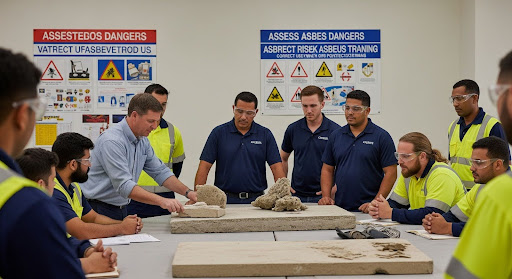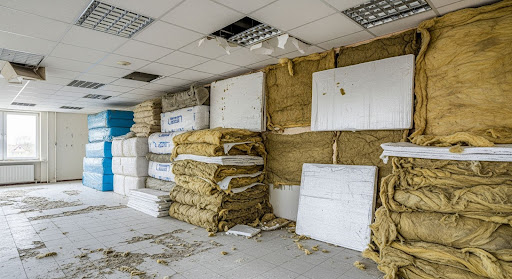I’ll be honest—when I first started my career in safety policy analysis, I naively assumed that asbestos was a thing of the past. After all, wasn’t it banned decades ago? Why would anyone still use it?
It wasn’t until I started digging deeper into construction projects and manufacturing processes that I realized, to my surprise, asbestos isn’t just an old problem—it’s still here, lurking in certain industries. So, is asbestos still used today? Let’s take a closer look at the state of things.
You’ve probably heard about the dangers of asbestos—it causes severe respiratory conditions like asbestosis, lung cancer, and mesothelioma.
So, why on earth would anyone still use it in construction or manufacturing? In short, while asbestos use has been heavily restricted, it’s still found in some materials and industries.
Let’s break it down so you can fully understand why this issue still matters in today’s safety landscape.
What Industries Still Use Asbestos?

1. Construction: The Silent Culprit
Despite its hazards, asbestos is still present in many older buildings. It was commonly used in construction until the 1980s in products like insulation, roofing, tiles, and cement, due to its heat resistance and durability.
If you work in demolition, renovation, or construction, there’s a chance you might encounter asbestos. It’s not always easy to spot, especially in buildings built before the 1980s.
In many countries, asbestos was not outright banned but rather regulated, meaning older structures may still contain it.
So, if you’re planning to do any home renovation or construction on an older building, testing for asbestos is a must.
Even if asbestos isn’t used as extensively as before, it’s still lurking in older materials that could be disturbed during renovations or demolitions.
2. Shipbuilding and Automotive Industries
While asbestos use has dramatically decreased, it’s still found in certain shipbuilding and automotive parts.
Specifically, in shipbuilding, asbestos was once heavily used for insulation and heat-resistant materials. Automotive parts like brake pads and clutches may still contain small amounts of asbestos, particularly in older vehicles.
Although manufacturers have switched to other materials, legacy products are still a concern for repair shops working on older models.
3. Manufacturing of Certain Products
Some industries still use asbestos in the production of specialized goods, such as certain types of brake linings, gaskets, and friction materials.
The reason for this is simple: asbestos provides an unmatched combination of heat resistance and strength.
However, even though these materials are less common, asbestos is still found in some high-performance applications due to its unique properties.
Why Isn’t Asbestos Completely Banned?

1. Regulation vs. Full Ban: A Gray Area
It’s a great question: Why hasn’t asbestos been fully banned everywhere? The short answer is that regulations differ by country.
In the United States, asbestos use is heavily regulated, but not completely outlawed. In fact, certain applications of asbestos are still permitted under very specific regulations. For example, some specialized asbestos-containing products are still legally produced, despite the known health risks.
In other countries like Canada and certain parts of the EU, more stringent bans have been implemented. Yet, there are countries where asbestos use is still widespread, especially in industries like construction, where alternatives may not be affordable or readily available.
2. Economic Factors and Legacy Usage
Another reason asbestos still exists is economic. Many older buildings, industrial machinery, and equipment still contain asbestos, and it can be costly to replace or remove.
In some cases, it’s easier and cheaper to leave asbestos in place, especially if it’s undisturbed and not posing an immediate risk.
Moreover, in certain developing countries, where regulations are lax and the economic incentive to avoid asbestos is lower, it may still be widely used. Inexpensive labor and cost-effective construction materials can often take precedence over health and safety standards.
How Can You Stay Safe from Asbestos Exposure?
1. Know Where Asbestos Is Likely to Be Found
If you’re working on older buildings or machinery, knowing where asbestos could be present is key.
For example, in construction, asbestos-containing materials are often found in things like insulation, floor tiles, roof shingles, and pipe insulation. If you’re unsure whether something contains asbestos, always have it tested before disturbing it.
If you work in construction, demolition, or HVAC, it’s especially important to undergo specialized training on asbestos identification and safety.
If you’re remodeling or doing DIY work on an older house, make sure you’re aware of the materials that may contain asbestos, and hire certified professionals for removal if needed.
2. Hire Licensed Professionals for Removal
If you do encounter asbestos during a renovation or demolition project, do not attempt to handle it yourself. Asbestos removal should always be conducted by licensed and trained professionals.
They have the equipment and expertise to remove asbestos safely, and they will follow the strict guidelines set forth by OSHA and other regulatory bodies.
3. Use Proper Safety Gear

For industries where asbestos exposure remains a risk, workers should be provided with proper protective gear, including respirators, disposable clothing, and gloves.
Additionally, it’s essential that workplaces follow strict protocols for decontaminating workers and equipment to prevent the spread of asbestos fibers.
FAQs on Is Asbestos Still Used
Is asbestos completely banned in the US?
No, asbestos is not completely banned in the United States. While its use has been restricted, certain types of asbestos-containing materials are still allowed under strict regulations.
However, its use in construction and manufacturing has significantly decreased.
How do I know if my home has asbestos?
If you live in an older home (built before the 1980s), there’s a good chance that asbestos was used in construction.
Common areas where asbestos may be found include floor tiles, insulation, ceiling tiles, and roofing. Have a certified professional conduct an asbestos inspection to determine whether it’s present.
What should I do if I find asbestos in my home or workplace?
If you discover asbestos in your home or workplace, don’t disturb it. If it’s in good condition and not likely to be disturbed, it might be safer to leave it alone.
However, if it’s damaged or in an area where it could be disturbed (like during renovations), contact an asbestos abatement professional immediately to remove it safely.
Can I remove asbestos myself?
No, asbestos removal should never be done by an untrained person. Handling asbestos improperly can release dangerous fibers into the air.
Always hire certified professionals who follow safety regulations to safely remove and dispose of asbestos-containing materials.
Asbestos – A Lingering Threat in Modern Times
Asbestos may no longer be used in the same quantities or as commonly as it was in the past, but it’s still far from being eliminated entirely.
Whether it’s in older buildings, machinery, or certain specialized products, asbestos remains a real threat.
However, the good news is that we’ve made significant strides in understanding its dangers and enforcing stricter regulations.
For those of you working in industries like construction, renovation, or manufacturing, it’s essential to stay informed about the risks associated with asbestos and follow proper protocols to ensure safety.
The future may be asbestos-free in some places, but for now, vigilance is key.



